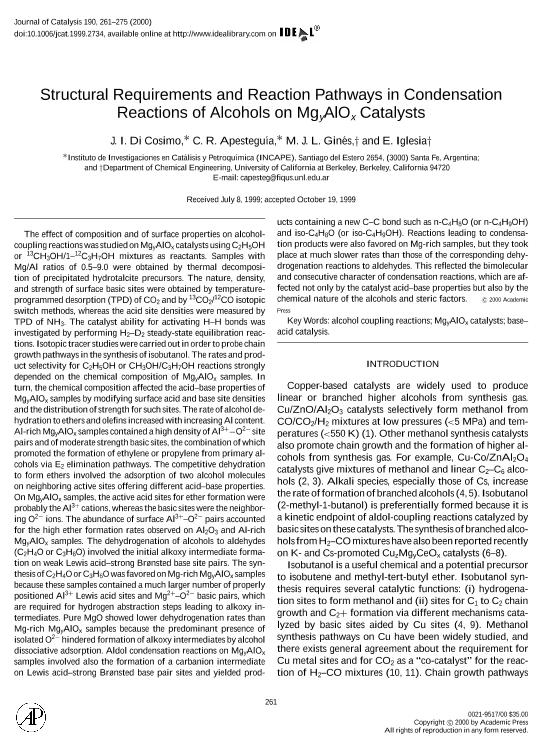Mostrar el registro sencillo del ítem
dc.contributor.author
Di Cosimo, Juana Isabel

dc.contributor.author
Apesteguia, Carlos Rodolfo

dc.contributor.author
Ginés, M. J. L.
dc.contributor.author
Iglesia, E.
dc.date.available
2018-02-23T20:30:10Z
dc.date.issued
2000-03
dc.identifier.citation
Di Cosimo, Juana Isabel; Apesteguia, Carlos Rodolfo; Ginés, M. J. L.; Iglesia, E.; Structural requirements and reaction pathways in condensation reactions of alcohols on MgyAlOx catalysts; Elsevier; Journal of Catalysis; 190; 2; 3-2000; 261-275
dc.identifier.issn
0021-9517
dc.identifier.uri
http://hdl.handle.net/11336/37072
dc.description.abstract
The effect of composition and of surface properties on alcohol-coupling reactions was studied on MgyAlOx catalysts using C2H5OH or 13CH3OH/1–12C3H7OH mixtures as reactants. Samples with Mg/Al ratios of 0.5–9.0 were obtained by thermal decomposition of precipitated hydrotalcite precursors. The nature, density, and strength of surface basic sites were obtained by temperature-programmed desorption (TPD) of CO2 and by 13CO2/12CO isotopic switch methods, whereas the acid site densities were measured by TPD of NH3. The catalyst ability for activating H–H bonds was investigated by performing H2–D2 steady-state equilibration reactions. Isotopic tracer studies were carried out in order to probe chain growth pathways in the synthesis of isobutanol. The rates and product selectivity for C2H5OH or CH3OH/C3H7OH reactions strongly depended on the chemical composition of MgyAlOx samples. In turn, the chemical composition affected the acid–base properties of MgyAlOx samples by modifying surface acid and base site densities and the distribution of strength for such sites. The rate of alcohol dehydration to ethers and olefins increased with increasing Al content. Al-rich MgyAlOx samples contained a high density of Al3+–O2− site pairs and of moderate strength basic sites, the combination of which promoted the formation of ethylene or propylene from primary alcohols via E2 elimination pathways. The competitive dehydration to form ethers involved the adsorption of two alcohol molecules on neighboring active sites offering different acid–base properties. On MgyAlOx samples, the active acid sites for ether formation were probably the Al3+ cations, whereas the basic sites were the neighboring O2− ions. The abundance of surface Al3+–O2− pairs accounted for the high ether formation rates observed on Al2O3 and Al-rich MgyAlOx samples. The dehydrogenation of alcohols to aldehydes (C2H4O or C3H6O) involved the initial alkoxy intermediate formation on weak Lewis acid–strong Brønsted base site pairs. The synthesis of C2H4O or C3H6O was favored on Mg-rich MgyAlOx samples because these samples contained a much larger number of properly positioned Al3+ Lewis acid sites and Mg2+–O2− basic pairs, which are required for hydrogen abstraction steps leading to alkoxy intermediates. Pure MgO showed lower dehydrogenation rates than Mg-rich MgyAlOx samples because the predominant presence of isolated O2− hindered formation of alkoxy intermediates by alcohol dissociative adsorption. Aldol condensation reactions on MgyAlOx samples involved also the formation of a carbanion intermediate on Lewis acid–strong Brønsted base pair sites and yielded products containing a new C–C bond such as n-C4H8O (or n-C4H9OH) and iso-C4H8O (or iso-C4H9OH). Reactions leading to condensation products were also favored on Mg-rich samples, but they took place at much slower rates than those of the corresponding dehydrogenation reactions to aldehydes. This reflected the bimolecular and consecutive character of condensation reactions, which are affected not only by the catalyst acid–base properties but also by the chemical nature of the alcohols and steric factors.
dc.format
application/pdf
dc.language.iso
eng
dc.publisher
Elsevier

dc.rights
info:eu-repo/semantics/openAccess
dc.rights.uri
https://creativecommons.org/licenses/by-nc-sa/2.5/ar/
dc.subject
Alcohol Coupling Reactions
dc.subject
Mgyalox Catalysts
dc.subject
Base–Acid Catalysis
dc.subject.classification
Otras Ingeniería Química

dc.subject.classification
Ingeniería Química

dc.subject.classification
INGENIERÍAS Y TECNOLOGÍAS

dc.title
Structural requirements and reaction pathways in condensation reactions of alcohols on MgyAlOx catalysts
dc.type
info:eu-repo/semantics/article
dc.type
info:ar-repo/semantics/artículo
dc.type
info:eu-repo/semantics/publishedVersion
dc.date.updated
2018-02-21T21:41:52Z
dc.journal.volume
190
dc.journal.number
2
dc.journal.pagination
261-275
dc.journal.pais
Países Bajos

dc.journal.ciudad
Amsterdam
dc.description.fil
Fil: Di Cosimo, Juana Isabel. Consejo Nacional de Investigaciones Científicas y Técnicas. Centro Científico Tecnológico Conicet - Santa Fe. Instituto de Investigaciones en Catálisis y Petroquímica ; Argentina
dc.description.fil
Fil: Apesteguia, Carlos Rodolfo. Consejo Nacional de Investigaciones Científicas y Técnicas. Centro Científico Tecnológico Conicet - Santa Fe. Instituto de Investigaciones en Catálisis y Petroquímica ; Argentina
dc.description.fil
Fil: Ginés, M. J. L.. University of California at Berkeley; Estados Unidos
dc.description.fil
Fil: Iglesia, E.. University of California at Berkeley; Estados Unidos
dc.journal.title
Journal of Catalysis

dc.relation.alternativeid
info:eu-repo/semantics/altIdentifier/doi/https://doi.org/10.1006/jcat.1999.2734
dc.relation.alternativeid
info:eu-repo/semantics/altIdentifier/url/https://www.sciencedirect.com/science/article/pii/S0021951799927343
Archivos asociados
